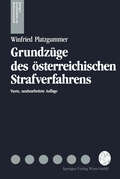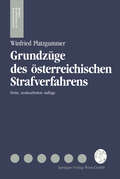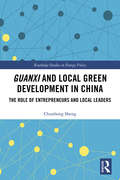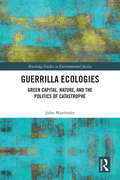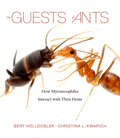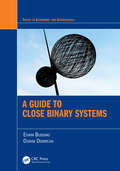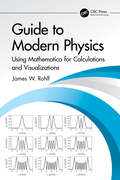- Table View
- List View
Grundzüge der Thermodynamik: mit historischen Anmerkungen
by Ingo MüllerGeschrieben für Studenten der Ingenieurwissenschaften, der Chemie und der Physik werden in diesem Lehrbuch die thermodynamischen Grundlagen sauber hergeleitet; dazu reichen die Mathematikkenntnisse des Grundstudiums. Das Buch enthält Übungsaufgaben und ist auch zum Selbststudium geeignet. Historische Anmerkungen lockern den Text auf und illustrieren die Begriffe von Temperatur, Energie und Entropie, indem sie deren schwierige Entstehung nachvollziehen. Unter sorgfältiger Herleitung der thermodynamischen Grundlagen behandelt der Autor zahlreiche Anwendungen in der Physik und der Chemie, der Werkstoffkunde, der Wärmeübertragung, der Gasdynamik usw. Die Neuauflage enthält zahlreiche Verbesserungen, behält aber das bewährte pädagogische Gesamtkonzept bei.
Grundzüge des österreichischen Strafverfahrens (Springers Kurzlehrbücher der Rechtswissenschaft)
by Winfried PlatzgummerDer Zeitpunkt dieser Neuauflage kommt nicht sehr gelegen. Der Entwurf StUG 1992 ist unterwegs, ich hatte das Gesetz gerne abgewartet, weil es eines auch wichtige Anderungen des Verfahrens bringen soil. Auch ist derzeit noch offen, was aus dem bis Ende 1992 befristeten Zeitgesetz BGBi1990 Nr. 455 (s. S. 150) werden wird. Anderseits ist die dritte Auflage schon fast vergriffen. So habe ich mich notgedrungen zur Neuauflage entschlossen, urn die Studenten, bei denen die »Grundziige" erfreulicherweise gut angekommen sind, nicht auf unbestimmte Zeit vertrosten zu miissen. Literatur und Rechtsprechung sind bis einschlieBlich Feber 1992 berucksich tigt. Die benutzten Systeme und Kommentare habe ich in der Einleitung, das neuere osterreichische Spezialschrifttum zu Beginn jeder groBeren Einheit ausgewiesen. Damit wollte ich dem Beniitzer den Zugang zu weiterfiihrenden Studien erleichtern, aber auch die Quellen angeben, aus denen ich geschopft habe. Ich habe sie aus unterschiedlichen Grunden nicht immer voll ausgeschopft, hauptsachlich deshalb, urn die Darstellung moglichst kurz und biindig zu halten. Eine rasche und, wie ich hoffe, veriaBliche Information ist heute umso wichtiger, als angesichts der iippig flieBenden Gesetzgebung sogar schon die meisten Gesetzesausgaben hinter der Rechtslage herhinken. Fiir die Zusammenstellung der Schrifttumsnachweise und des Sachverzeich nisses habe ich Herrn Univ.-Assistenten DDr. Peter Lewis ch und Herrn cando iur. Johannes Z a h I r zu danken. Bedanken mochte ich mich aber auch bei Herrn Univ.-Dozenten Dr. Wolfgang Brandstetter und bei den Rezensenten der Vorauflagen, die mir wichtige Anregungen gegeben haben.
Grundzüge des österreichischen Strafverfahrens (Springers Kurzlehrbücher der Rechtswissenschaft)
by Winfried PlatzgummerDie Neuauflage gab mir Gelegenheit, das Geschworenen- und Schöffengesetz 1990 und die Literatur und Rechtsprechung bis einschließlich Mai 1990 einzuar beiten. Das Kapitel über das Vorverfahren wurde zum Teil neu gefaßt. Beim bezirksgerichtlichen Verfahren habe ich die Neuregelung des § 453 (BGB11990 Nr. 455), obwohl es sich dabei nur um ein Zeitgesetz handelt, berücksichtigt, weil sie für den Studenten in mancher Hinsicht aufschlußreich ist. Im übrigen sollen die Grundzüge ja auch anderen Benützern eine rasche Information ermöglichen, was heute umso wichtiger ist, als angesichts der üppig fließenden Gesetzgebung sogar die meisten Gesetzesausgaben schon hinter der jeweiligen Rechtslage herhinken. Die benutzten Systeme und Kommentare habe ich in der Einleitung, das neuere österreichische Spezialschrifttum zu Beginn jeder größeren Einheit ausge wiesen, um so die Quellen anzugeben, aus denen ich geschöpft habe, aber auch um dem Benützer den Zugang zu weiterführenden Studien zu erleichtern. Für die Zusammenstellung der Schrifttumsnachweise und des Sachverzeich nisses habe ich Herrn Univ.-Assistenten DDr. Peter Lewisch, für sonstige Hilfe auch Herrn Univ.-Assistenten Dr. Wolfgang Brandstetter und den Rezensenten der letzten Auflagen zu danken.
Grüne Wahrheiten: Das Buch zur Ressourcenwende
by Friedrich Schmidt-BleekEs ist das brandaktuelle Buch für die zentrale, globale Herausforderung unserer Zeit. In seinem Vermächtnis, zeigt sich Friedrich Schmidt-Bleek erneut als richtunggebender Vordenker, als Visionär, Umweltforscher und Gestalter einer zukunftsfähigen Umweltpolitik. Ein erfolgreiches Ökologiekonzept muss alle die Klimakrise auslösenden und Umwelt zerstörenden Bereiche in ihren ineinandergreifenden Wirkungszusammenhängen ganzheitlich betrachten. Darauf kann eine verantwortungsbewusste Politik mit klaren Zielen, mit richtungssicheren sozialen, ökologischen und wirtschaftlichen Indikatoren aufbauen. Der zentrale Hebel zur Bewältigung der Klimakrise und Beendigung der Umweltzerstörung besteht für den Autor in der qualitativen Veränderung der Ressourcenabhängigkeit von Produkten und Dienstleistungen durch eine wesentliche Minimierung des Ressourcenverbrauchs. Mit dem seit 1990 entwickelten MIPS Konzept (Material-Input pro Serviceeinheit) ist ein Parameter entstanden, der den Ressourcenverbrauch im Lebenszyklus von Produkten und Dienstleistungen berechenbar und damit veränderbar macht. Damit ist der Weg zu zukunftsfähigen, nachhaltigen Produkten gangbar geworden. Anschaulich und allgemeinverständlich geschrieben legt Schmidt-Bleek hier sein über Jahrzehnte verfeinertes, und vorsorgendes Ökologiekonzept dar, dass eine gesamtgesellschaftliche Transformation und Ressourcenwende ermöglicht und uns allen Wege aufzeigt, aktiv daran teilzuhaben zu können.
Guanacos and People in Patagonia: A Social-Ecological Approach to a Relationship of Conflicts and Opportunities (Natural and Social Sciences of Patagonia)
by Gabriela Lichtenstein Pablo CarmanchahiThis book relates one of the most representative species of Patagonian wildlife, the guanaco, to human societies across time, and explores how that relationship has changed over time due to different land uses and productive interests. The book provides information to understand these interactions, and contextualizes the current situation of this species. In some cases, it proposes possible solutions to conflicts, and also shows ongoing activities aimed at sustainable use and conservation. The audience for this book includes researchers, graduate students, policy makers and conservation and rural development professionals. In addition, it will serve as a tool for application authorities and field technicians on the use and conservation of wildlife, to define management actions for this species.
Guanxi and Local Green Development in China: The Role of Entrepreneurs and Local Leaders (Routledge Studies in Environmental Policy)
by Chunhong ShengThis book examines the factors which contribute to local green development in China and employs political ecology to analyze the relationship between power and the environment. Specifically, it looks at which actors control access to resources and are therefore able to promote environmental progress. Following the reform and opening-up of China in the 1970s, entrepreneurs and local officials profited economically and politically and formed close relationships, known as guanxi in China. As a result, they have also been criticized as those responsible for the associated ecological damage. This book does not contest this association, but instead argues that the current literature places too much emphasis on their negative influence and the positive influence of their environmental work has been neglected. Building on three case studies where local green development is being pursued, Shanghai Pudong New Area, Baoding, and Wuning, this book shows how local officials and entrepreneurs can also be the crusaders of a greener environment at the local level in China. This book will be of great interest to students and scholars of Chinese studies, with a particular interest in environmental policy and politics, business and society, as well as those interested in sustainable development more broadly.
Guanxi and Local Green Development in China: The Role of Entrepreneurs and Local Leaders (Routledge Studies in Environmental Policy)
by Chunhong ShengThis book examines the factors which contribute to local green development in China and employs political ecology to analyze the relationship between power and the environment. Specifically, it looks at which actors control access to resources and are therefore able to promote environmental progress. Following the reform and opening-up of China in the 1970s, entrepreneurs and local officials profited economically and politically and formed close relationships, known as guanxi in China. As a result, they have also been criticized as those responsible for the associated ecological damage. This book does not contest this association, but instead argues that the current literature places too much emphasis on their negative influence and the positive influence of their environmental work has been neglected. Building on three case studies where local green development is being pursued, Shanghai Pudong New Area, Baoding, and Wuning, this book shows how local officials and entrepreneurs can also be the crusaders of a greener environment at the local level in China. This book will be of great interest to students and scholars of Chinese studies, with a particular interest in environmental policy and politics, business and society, as well as those interested in sustainable development more broadly.
Guardians Of The Parks: A History Of The National Parks And Conservation Association
by John C. MilesFirst published in 1995. This volume traces the origin and development of America's national park citizen 'watchdog' organisation. Giving an insider's perspective, and reflecting an outsiders quest for objectivity, it will be of interest to every park enthusiast and conversation historian.
Guardians Of The Parks: A History Of The National Parks And Conservation Association
by John C. MilesFirst published in 1995. This volume traces the origin and development of America's national park citizen 'watchdog' organisation. Giving an insider's perspective, and reflecting an outsiders quest for objectivity, it will be of interest to every park enthusiast and conversation historian.
Guardians of the Planet: How to be an Eco-Hero
by Clive GiffordThis environmentally positive book contains everything children need to become guardians of the planet. Kids can learn how to become keepers of the coasts, friends of the forests, home heroes and much more through a mix of compelling facts, creative activities and proactive tips.Key environmental topics are clearly explained, and the easy-to-follow projects and suggestions help to put the issues in an everyday context. From reusing clothes and composting food to reducing water waste and giving wildlife a helping hand, this book will encourage children to engage with environmental problems and inspire them to take care of our wonderful planet. The book includes an introduction by ClientEarth, an organization that uses environmental law to protect oceans, forests and other habitats, as well as all people, and a foreword by Brian Eno.All royalties from the sales of this book go to ClientEarth.Printed using waterless ink on FSC paper.
Guerrilla Ecologies: Green Capital, Nature, and the Politics of Catastrophe (Routledge Studies in Environmental Justice)
by John MaerhoferThis book intervenes in contemporary debates about climate activism, militancy, and strategy that have been gathering force in radical ecological circles. It responds to some of the urgent questions about utilizing militancy as part of the overall effort to foster an ecosocialist society. Building upon the crucial work of scholars and activists from the 1970s to the present, such as Carolyn Merchant, Ursula Heise, Raj Patel, Joan Martinez Alier, Neil Smith, and Mark Dowie, this book discusses and regenerates key principles of guerrilla ecology. It presents a significant critique of green capital and its impact on the shape of environmental and climate justice movements. From car manufacturers dedicating profits to reforestation, to big oil conglomerates funneling money into universities that are developing techno-fixes which may stave off ecological disaster, green capital has become the mainstay of contemporary cultural, political, and economic reproduction – aiming to fuse profitability and sustainability. The book brings together discussion on key topics in a range of contexts including biopiracy and biocolonialism, indigenous resistance, extractivism, anti-imperialism, ecotage, and eco-militancy. It will attract scholarly readers from diverse spaces in the environmental humanities, environmental and climate justice, radical ecology, and philosophy.
Guerrilla Ecologies: Green Capital, Nature, and the Politics of Catastrophe (Routledge Studies in Environmental Justice)
by John MaerhoferThis book intervenes in contemporary debates about climate activism, militancy, and strategy that have been gathering force in radical ecological circles. It responds to some of the urgent questions about utilizing militancy as part of the overall effort to foster an ecosocialist society. Building upon the crucial work of scholars and activists from the 1970s to the present, such as Carolyn Merchant, Ursula Heise, Raj Patel, Joan Martinez Alier, Neil Smith, and Mark Dowie, this book discusses and regenerates key principles of guerrilla ecology. It presents a significant critique of green capital and its impact on the shape of environmental and climate justice movements. From car manufacturers dedicating profits to reforestation, to big oil conglomerates funneling money into universities that are developing techno-fixes which may stave off ecological disaster, green capital has become the mainstay of contemporary cultural, political, and economic reproduction – aiming to fuse profitability and sustainability. The book brings together discussion on key topics in a range of contexts including biopiracy and biocolonialism, indigenous resistance, extractivism, anti-imperialism, ecotage, and eco-militancy. It will attract scholarly readers from diverse spaces in the environmental humanities, environmental and climate justice, radical ecology, and philosophy.
The Guests of Ants: How Myrmecophiles Interact with Their Hosts
by Bert Hölldobler Christina L. KwapichA fascinating examination of socially parasitic invaders, from butterflies to bacteria, that survive and thrive by exploiting the communication systems of ant colonies. Down below, on sidewalks, in fallen leaves, and across the forest floor, a covert invasion is taking place. Ant colonies, revered and studied for their complex collective behaviors, are being infiltrated by tiny organisms called myrmecophiles. Using incredibly sophisticated tactics, various species of butterflies, beetles, crickets, spiders, fungi, and bacteria insert themselves into ant colonies and decode the colonies’ communication system. Once able to “speak the language,” these outsiders can masquerade as ants. Suddenly colony members can no longer distinguish friend from foe. Pulitzer Prize–winning author and biologist Bert Hölldobler and behavioral ecologist Christina L. Kwapich explore this remarkable phenomenon, showing how myrmecophiles manage their feat of code-breaking and go on to exploit colony resources. Some myrmecophiles slip themselves into their hosts’ food sharing system, stealing liquid nutrition normally exchanged between ant nestmates. Other intruders use specialized organs and glandular secretions to entice ants or calm their aggression. Guiding readers through key experiments and observations, Hölldobler and Kwapich reveal a universe of behavioral mechanisms by which myrmecophiles turn ants into unwilling servants. As The Guests of Ants makes clear, symbiosis in ant societies can sometimes be mutualistic, but, in most cases, these foreign intruders exhibit amazingly diverse modes of parasitism. Like other unwelcome guests, many of these myrmecophiles both disrupt and depend on their host, making for an uneasy coexistence that nonetheless plays an important role in the balance of nature.
The Guiana Travels of Robert Schomburgk Volume II The Boundary Survey, 1840–1844 (Hakluyt Society, Third Series)
by Peter RivièreThis is the second of a pair of volumes publishing the unedited full reports of Schomburgk's travels in Guiana between 1835 and 1844, previously available only in greatly abridged and heavily edited versions. After his explorations in Guiana between 1835 and 1839 on behalf of the Royal Geographical Society, which are the subject of Volume I of The Guiana Travels of Robert Schomburgk 1835-1844, Robert Schomburgk travelled to London. He was appointed Her Majesty's Commissioner for Boundaries with the duty to survey the boundaries of British Guiana, hitherto undefined. His surveys between 1841 and 1843 consisted of three journeys. The first took him to the mouth of the Orinoco River, from where he traced the boundary south-westward to the Cuyuni River, before returning to Georgetown. The second journey involved the survey of the boundary with Brazil: first, south to the sources of the Takutu River; and then north to Mount Roraima. In the third he covered the boundary with Dutch Guiana (modern Surinam), which involved an arduous trip down the length of the Corentyne River. Schomburgk returned to London in 1844 and was knighted for his services. Volume II of The Guiana Travels contains his reports of these journeys. In abbreviated form they appeared in the Journal of the Royal Geographical Society. Here they are published in full, including the material censored by the Colonial Office, which mainly details abuses of the native population committed by Venezuelans and Brazilians. In an 'Epilogue' an account is provided of his later career. The volume also includes two appendices: a summary of the boundary disputes which arose as a result of Schomburgk's survey and a vocabulary of vernacular plant names.
The Guiana Travels of Robert Schomburgk Volume II The Boundary Survey, 1840–1844 (Hakluyt Society, Third Series)
by Peter RivièreThis is the second of a pair of volumes publishing the unedited full reports of Schomburgk's travels in Guiana between 1835 and 1844, previously available only in greatly abridged and heavily edited versions. After his explorations in Guiana between 1835 and 1839 on behalf of the Royal Geographical Society, which are the subject of Volume I of The Guiana Travels of Robert Schomburgk 1835-1844, Robert Schomburgk travelled to London. He was appointed Her Majesty's Commissioner for Boundaries with the duty to survey the boundaries of British Guiana, hitherto undefined. His surveys between 1841 and 1843 consisted of three journeys. The first took him to the mouth of the Orinoco River, from where he traced the boundary south-westward to the Cuyuni River, before returning to Georgetown. The second journey involved the survey of the boundary with Brazil: first, south to the sources of the Takutu River; and then north to Mount Roraima. In the third he covered the boundary with Dutch Guiana (modern Surinam), which involved an arduous trip down the length of the Corentyne River. Schomburgk returned to London in 1844 and was knighted for his services. Volume II of The Guiana Travels contains his reports of these journeys. In abbreviated form they appeared in the Journal of the Royal Geographical Society. Here they are published in full, including the material censored by the Colonial Office, which mainly details abuses of the native population committed by Venezuelans and Brazilians. In an 'Epilogue' an account is provided of his later career. The volume also includes two appendices: a summary of the boundary disputes which arose as a result of Schomburgk's survey and a vocabulary of vernacular plant names.
A Guide to Career Resilience: For Women and Under-Represented Groups
by Eve Sprunt Maria Angela CapelloMentors and sponsors are essential to career success, but these close relationships are not always free from trouble. This book shares advice and practical examples on how to survive and thrive throughout your career by differentiating between good and bad guidance you receive from mentors and sponsors. Real-life guidance is provided on how to manage troubled mentoring and sponsoring relationships at work.
A Guide to Close Binary Systems (ISSN)
by Edwin Budding Osman DemircanIntroduction to Close Binary Systems provides a comprehensive survey and guide to the fast-moving field of multiple, specifically binary, stars, with an up to date account of research around 'close', i.e. interacting pairs. Such interactions allow direct quantification of stellar properties, opening up factual insights into basic building blocks of the Universe.The book provides a much needed update for the seminal Close Binary Systems of Zdenĕk Kopal. Following a comparable plan, it presents relevant subject matter with an emphasis on building a framework of understanding to serve as a supporting resource for students and researchers. The text starts from a general historical background and progresses into the main theoretical ideas supporting our prima facie interpretation of observations. The central chapters explore further into these observational methods, arranged according to the classic subdivisions of astrometry, spectroscopy and photometry. Optimal inversion of observational data into model parametrization is a theme through these chapters. Significant here is the problem of how non-uniqueness in modelling affects interpretation. The underlying issues of stellar evolution bearing on observational evidence become paramount in the last four chapters. The book proceeds step-by-step from directly understandable examples of unevolved pairs to the challenging cases where stars are found in more and more extreme conditions, leading up to the mergers of massive black hole pairs seen in the new field of gravitational wave astronomy. This is a valuable reference for postgraduate and advanced undergraduate students working in mainstream areas of stellar astrophysics, with applications also to exoplanet research which shares some methodological features. Course designers for stellar astrophysics will find a useful selection of topics within this book.Key features:• Provides a well-explained and backgrounded, up-to-date account of close binary systems, in a fast-moving field of research that is growing in scientific importance• Surveys a wide range of case-studies within the context of binary and multiple star systems• Fills an acknowledged gap in current literatureCover Image: A public memorial to Zdenek Kopal in his home town (birthplace) of Litomysl in Czechia.
A Guide to Close Binary Systems (ISSN)
by Edwin Budding Osman DemircanIntroduction to Close Binary Systems provides a comprehensive survey and guide to the fast-moving field of multiple, specifically binary, stars, with an up to date account of research around 'close', i.e. interacting pairs. Such interactions allow direct quantification of stellar properties, opening up factual insights into basic building blocks of the Universe.The book provides a much needed update for the seminal Close Binary Systems of Zdenĕk Kopal. Following a comparable plan, it presents relevant subject matter with an emphasis on building a framework of understanding to serve as a supporting resource for students and researchers. The text starts from a general historical background and progresses into the main theoretical ideas supporting our prima facie interpretation of observations. The central chapters explore further into these observational methods, arranged according to the classic subdivisions of astrometry, spectroscopy and photometry. Optimal inversion of observational data into model parametrization is a theme through these chapters. Significant here is the problem of how non-uniqueness in modelling affects interpretation. The underlying issues of stellar evolution bearing on observational evidence become paramount in the last four chapters. The book proceeds step-by-step from directly understandable examples of unevolved pairs to the challenging cases where stars are found in more and more extreme conditions, leading up to the mergers of massive black hole pairs seen in the new field of gravitational wave astronomy. This is a valuable reference for postgraduate and advanced undergraduate students working in mainstream areas of stellar astrophysics, with applications also to exoplanet research which shares some methodological features. Course designers for stellar astrophysics will find a useful selection of topics within this book.Key features:• Provides a well-explained and backgrounded, up-to-date account of close binary systems, in a fast-moving field of research that is growing in scientific importance• Surveys a wide range of case-studies within the context of binary and multiple star systems• Fills an acknowledged gap in current literatureCover Image: A public memorial to Zdenek Kopal in his home town (birthplace) of Litomysl in Czechia.
Guide to Electricity and Magnetism: Using Mathematica for Calculations and Visualizations
by James W. RohlfThis is a “how to guide” for a calculus-based introductory course in electricity and magnetism. Students taking the subject at an intermediate or advanced level may also find it to be a useful reference. The calculations are performed in Mathematica, and stress graphical visualization, units, and numerical answers. The techniques show the student how to learn the physics without being hung up on the math. There is a continuing movement to introduce more advanced computational methods into lower-level physics courses. Mathematica is a unique tool in that code is written as "human readable" much like one writes a traditional equation on the board.Key Features: Concise summary of the physics concepts. Over 300 worked examples in Mathematica. Tutorial to allow a beginner to produce fast results. The companion code for this book can be found here: https://physics.bu.edu/~rohlf/code.html
Guide to Electricity and Magnetism: Using Mathematica for Calculations and Visualizations
by James W. RohlfThis is a “how to guide” for a calculus-based introductory course in electricity and magnetism. Students taking the subject at an intermediate or advanced level may also find it to be a useful reference. The calculations are performed in Mathematica, and stress graphical visualization, units, and numerical answers. The techniques show the student how to learn the physics without being hung up on the math. There is a continuing movement to introduce more advanced computational methods into lower-level physics courses. Mathematica is a unique tool in that code is written as "human readable" much like one writes a traditional equation on the board.Key Features: Concise summary of the physics concepts. Over 300 worked examples in Mathematica. Tutorial to allow a beginner to produce fast results. The companion code for this book can be found here: https://physics.bu.edu/~rohlf/code.html
A Guide to Empirical Orthogonal Functions for Climate Data Analysis
by Antonio Navarra Valeria SimonciniClimatology and meteorology have basically been a descriptive science until it became possible to use numerical models, but it is crucial to the success of the strategy that the model must be a good representation of the real climate system of the Earth. Models are required to reproduce not only the mean properties of climate, but also its variability and the strong spatial relations between climate variability in geographically diverse regions. Quantitative techniques were developed to explore the climate variability and its relations between different geographical locations. Methods were borrowed from descriptive statistics, where they were developed to analyze variance of related observations-variable pairs, or to identify unknown relations between variables. A Guide to Empirical Orthogonal Functions for Climate Data Analysis uses a different approach, trying to introduce the reader to a practical application of the methods, including data sets from climate simulations and MATLAB codes for the algorithms. All pictures and examples used in the book may be reproduced by using the data sets and the routines available in the book .Though the main thrust of the book is for climatological examples, the treatment is sufficiently general that the discussion is also useful for students and practitioners in other fields. Supplementary datasets are available via http://extra.springer.com
A Guide to Field Instrumentation in Geotechnics: Principles, Installation and Reading
by Richard BassettGeotechnical instrumentation is used for installation, monitoring and assessment on any sizeable project, particularly in urban areas, and is used for recording, controlled remedial work, and safety. This unique and up-to-date book deals with the conceptual philosophy behind the use of instruments, and then systematically covers their practical use
Guide to Modern Physics: Using Mathematica for Calculations and Visualizations
by James W. RohlfThis is a "how to guide" for making beginning calculations in modern physics. The academic level is second year college physical science and engineering students. The calculations are performed in Mathematica, and stress graphical visualization, units, and numerical answers. The techniques show the student how to learn the physics without being hung up on the math. There is a continuing movement to introduce more advanced computational methods into lower-level physics courses. Mathematica is a unique tool in that code is written as "human readable" much like one writes a traditional equation on the board. Key Features: Concise summary of the physics concepts. Over 300 worked examples in Mathematica. Tutorial to allow a beginner to produce fast results. The companion code for this book can be found here: https://physics.bu.edu/~rohlf/code.html James Rohlf is a Professor at Boston University. As a graduate student he worked on the first experiment to trigger on hadron jets with a calorimeter, Fermilab E260. His thesis (G. C. Fox, advisor, C. Barnes, R. P. Feynman, R. Gomez) used the model of Field and Feynman to compare observed jets from hadron collisions to that from electron-positron collisions and made detailed acceptance corrections to arrive at first the measurement of quark-quark scattering cross sections. His thesis is published in Nuclear Physics B171 (1980) 1. At the Cornell Electron Storage Rings, he worked on the discovery of the Upsilon (4S) resonance and using novel event shape variables developed by Stephen Wolfram and his thesis advisor, Geoffrey Fox. He performed particle identification of kaons and charmed mesons to establish the quark decay sequence, b –> c. At CERN, he worked on the discovery of the W and Z bosons and measurement of their properties. Presently, he is working on the Compact Muon Solenoid (CMS) experiment at the CERN Large Hadron Collider (LHC) which discovered the Higgs boson and is searching for new phenomena beyond the standard model.
Guide to Modern Physics: Using Mathematica for Calculations and Visualizations
by James W. RohlfThis is a "how to guide" for making beginning calculations in modern physics. The academic level is second year college physical science and engineering students. The calculations are performed in Mathematica, and stress graphical visualization, units, and numerical answers. The techniques show the student how to learn the physics without being hung up on the math. There is a continuing movement to introduce more advanced computational methods into lower-level physics courses. Mathematica is a unique tool in that code is written as "human readable" much like one writes a traditional equation on the board. Key Features: Concise summary of the physics concepts. Over 300 worked examples in Mathematica. Tutorial to allow a beginner to produce fast results. The companion code for this book can be found here: https://physics.bu.edu/~rohlf/code.html James Rohlf is a Professor at Boston University. As a graduate student he worked on the first experiment to trigger on hadron jets with a calorimeter, Fermilab E260. His thesis (G. C. Fox, advisor, C. Barnes, R. P. Feynman, R. Gomez) used the model of Field and Feynman to compare observed jets from hadron collisions to that from electron-positron collisions and made detailed acceptance corrections to arrive at first the measurement of quark-quark scattering cross sections. His thesis is published in Nuclear Physics B171 (1980) 1. At the Cornell Electron Storage Rings, he worked on the discovery of the Upsilon (4S) resonance and using novel event shape variables developed by Stephen Wolfram and his thesis advisor, Geoffrey Fox. He performed particle identification of kaons and charmed mesons to establish the quark decay sequence, b –> c. At CERN, he worked on the discovery of the W and Z bosons and measurement of their properties. Presently, he is working on the Compact Muon Solenoid (CMS) experiment at the CERN Large Hadron Collider (LHC) which discovered the Higgs boson and is searching for new phenomena beyond the standard model.


